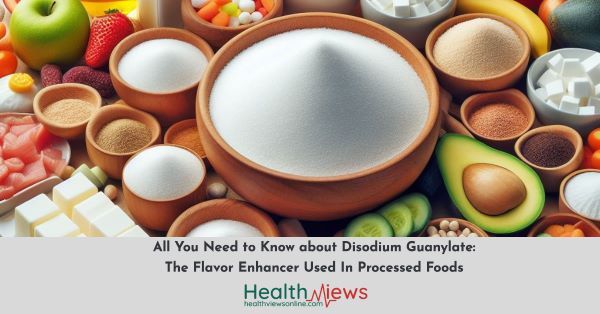When it comes to processed foods, achieving the perfect taste is crucial for consumer satisfaction. It is a flavor enhancer that has become increasingly popular for its ability to elevate the savory profile of food products. While flavor enhancers are commonly used in many processed foods, questions have arisen about its safety and potential health effects. This article aims to provide a comprehensive overview of the Flavor Enhancer E627 aka Disodium Guanylate, including its definition, sources, applications, associated risks, regulatory status, and strategies for minimizing exposure. (Source)
What is Disodium Guanylate – Flavor Enhancer E627?
It is a flavor enhancer derived from guanosine monophosphate, a nucleotide found naturally in various foods. It is typically produced through fermentation and appears as a white, crystalline powder. It’s often used in conjunction with other flavor enhancers, such as Monosodium Glutamate (MSG), to enhance the overall taste profile of food products. (Source)
What is the List of Foods Containing Disodium Guanylate?
It can be found in a wide range of processed foods, including:
- Snack foods (chips, crackers)
- Instant noodles
- Seasonings and condiments
- Processed meats (sausages, canned meats)
- Soups and broths
- Ready-to-eat meals
- Fast food and restaurant dishes (Source)
Why is Flavor Enhancer E627 Used in the Food Industry? What are the Applications
It serves as a versatile flavor enhancer in the food industry by:
- Intensifying the savory taste of foods, known as umami, and enhancing overall flavor complexity.
- Masking undesirable flavors and improving the palatability of processed foods.
- Balancing and harmonizing flavor profiles in culinary preparations.
- Increasing consumer acceptance and preference for certain products.
The Risky and Harmful side effects of Disodium Guanylate on Human Health are:
While Disodium Guanylate is generally recognized as safe (GRAS) by regulatory agencies when consumed in moderate amounts, some individuals may experience adverse reactions, including:
- Allergic reactions: Sensitivity to it is rare but can manifest as skin rash, itching, or respiratory symptoms in susceptible individuals.
- Gastrointestinal discomfort: Ingesting large amounts of foods containing Disodium Guanylate may lead to digestive issues such as bloating, gas, or diarrhea in some people.
- Asthma exacerbation: Individuals with asthma may experience worsening symptoms after consuming foods with Disodium Guanylate due to its potential to trigger respiratory reactions. (Source)
What are the FDA regulations for Flavor Enhancer Disodium Guanylate?
The U.S. Food and Drug Administration (FDA) regulates the use of it as a food additive and considers it Generally Recognized as Safe (GRAS) when used within specified limits. The FDA requires the inclusion of Disodium Guanylate on ingredient labels when present in processed foods above certain thresholds.
List of Diseases Associated with High Disodium Guanylate Levels:
Consuming excessive amounts of it has not been conclusively linked to specific diseases. However, overconsumption of processed foods high in Disodium Guanylate may contribute to health issues associated with poor dietary habits, such as obesity, cardiovascular disease, and metabolic disorders.
How to Minimize the Exposure to Food Chemicals Disodium Guanylate Used in Processed Food?
To minimize potential risks associated with it’s consumption, consider the following recommendations:
- Read food labels carefully and choose products with minimal or no added Disodium Guanylate.
- Limit consumption of heavily processed foods and opt for fresh, whole ingredients whenever possible.
- Be mindful of portion sizes and balance your diet with a variety of nutrient-rich foods to reduce reliance on processed options.
- Monitor your body’s response to Disodium Guanylate-containing foods and limit intake if you experience adverse reactions.
- Advocate for transparent labeling practices and stricter regulations regarding the use of flavor enhancers in processed foods.
In conclusion, it plays a significant role in enhancing the flavor of many processed foods, but its safety and potential health effects warrant careful consideration. By understanding its sources, applications, associated risks, and regulatory considerations, consumers can make informed choices to promote their health and well-being.

Also Read: Quickly Know all about Food Borne Infection Listeria monocytogenes
Sources and References:
- U.S. Food and Drug Administration (FDA)
- European Food Safety Authority (EFSA)
- National Institutes of Health (NIH)
- World Health Organization (WHO)
- Food and Agriculture Organization of the United Nations (FAO)
- Scientific journals and peer-reviewed research articles.




